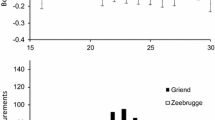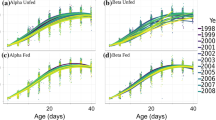Abstract
Procellariiform seabirds such as short-tailed shearwaters Puffinus tenuirostris accumulate large quantities of lipid during the nestling period. The functional significance of this pattern of development remains unclear, but has been related both to temporal variation in feeding conditions around the colony and to stochastic variation in the foraging success of individual parents. This paper examines temporal and age-specific variation in the pattern of food delivery to nestling short-tailed shearwaters, which have one of the lowest provisioning rates of any procellariiforms and are known to experience occasional long intervals between feeds. We assess whether variation in the provisioning rates of chicks was associated primarily with temporal variation in food delivery at the level of the colony or with stochastic variation in food delivery at the level of the individual. We then discuss this variability in the context of nestling obesity. For all but the youngest chick age-classes, individual meals delivered by adults averaged 141 g, which was 25% of adult body mass. The proportion of chicks fed each night was low (49%) and highly variable (coefficient of variation = 82%), which means that occasional long intervals between feeds would be expected to arise simply by chance. In keeping with this, intervals between feeding events for individual chicks followed a negative exponential distribution with a mean of 2 nights and a maximum interval of 13 nights. There was significant temporal variation in food delivery, but deviations from expected values for both feeding frequency and meal size were restricted to a small number of nights, included values both higher and lower than expected and did not persist for more than 2 nights in succession. These data suggest that even among those species with very low feeding frequencies and occasional long intervals between feeds, nestling obesity in Procellariiformes should be regarded as a response to chronic stochastic variability in food delivery at the level of the individual chick rather than as insurance against sporadic temporal variation at the level of the colony.
Similar content being viewed by others
Author information
Authors and Affiliations
Additional information
Received: 3 March 1997 / Accepted: 10 May 1997
Rights and permissions
About this article
Cite this article
Hamer, K., Nicholson, L., Hill, J. et al. Nestling obesity in procellariiform seabirds: temporal and stochastic variation in provisioning and growth of short-tailed shearwaters Puffinus tenuirostris . Oecologia 112, 4–11 (1997). https://doi.org/10.1007/s004420050276
Issue Date:
DOI: https://doi.org/10.1007/s004420050276




